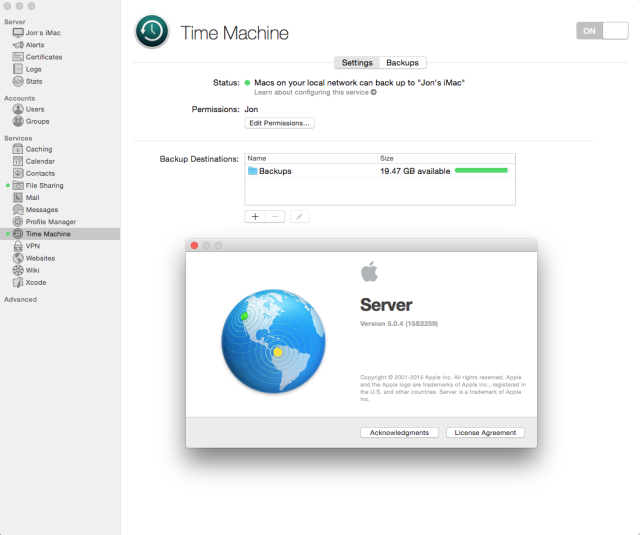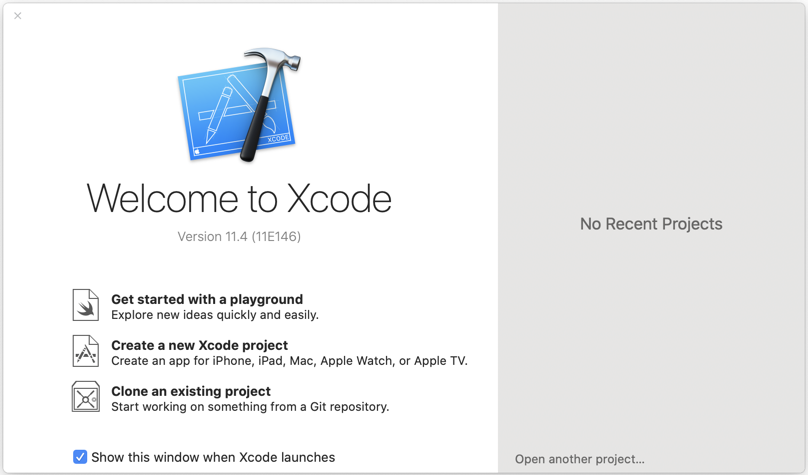View more Tutorials:
With 10.13.6 the most recent version of Xcode you can use is Xcode 10.1. Also, Macs made in 2010 cannot run macOS 10.14.4, which is why that version of macOS is not available to you as an update. Your Mac can't be updated past macOS 10.13.x. You can do one of the following: Stick with Xcode 10.1. This is available in Xcode 10, and I really needs to install it on my Mac, because iOS 12 and greater requires this feature in Auto-renewable Subscription modules in order to approve app from iTunes App Store team. Instructions: Homebrew: examples: http://quantlib.org/reference/examples.html. Sep 13, 2021 The Mac OS X El Capitan 10.11 is among the latest Apple Operating System with greater security and better performance. Xcode For Mac 10.11.6 Download Free; Download Xcode Apple; 8/10 (113 votes) - Download macOS El Capitan Mac Free. The twelfth version of Mac OS X appeared in 2015.
1- Download XCode

A small Apple Automator application which makes it possible to use the traditional Mac OS X system-font 'Lucida Grande' on OS X 10.11 El Capitan. Download: (Version 1.0) Or browse to /Packages and download the latest ZIP manually.
- Mac OS X, El Capitan Version 10.11 (iMac) Description When running the Qt installer for the open source version of Qt Creator for Mac OS X (El Capitan version 10.11), immediately after the prompt to log in to Qt (which is successful) I receive the following error.
- Download Perl::XCode - XCode Extensions for Perl for free. Perl::XCode is a package containing a number of predefined XCode templates for project and other XCode development uses. The goal is to provide a broad base of XCode development aids for Perl programmers.
- To install Xcode on Windows, you must install macOS on Windows. Because Xcode is not available for Windows and only for Mac computers. Therefore, you must first install macOS Mojave on Windows and then you will be able to install Xcode. Don’t worry because you can install the Mac operating system on your Windows with the help of virtual machines.
| XCode | Minimum Mac OS Version |
| XCode 11.4.1 | macOS Catalina 10.15.4 |
| XCode 11.4 | macOS Catalina 10.15.2 |
| XCode 11.3.1 | |
| XCode 11.3 | |
| XCode 11.2.1 | macOS Catalina 10.15 |
| XCode 11.2 | |
| XCode 11.1 | |
| XCode 11 | |
| XCode 10.3 | macOS 10.14.6 |
| XCode 10.2 | macOS 10.14.4 |
| XCode 10.1 | macOS 10.14.1 |
| XCode 10 | macOS 10.14 |
| XCode 9.x | macOS 10.13.2 |
| XCode 8.x | macOS 10.12 |
| XCode 7.x | OS X 10.11 |
Xcode For Mac 10.11.6
2- Installing XCode (XIP)
3- Installing XCode (DMG)
What Is Xcode For Mac
Xcode For Os X 10.11.6
1. Xcode includes the Xcode IDE, Swift and C/C++/Objective-C compilers, Instruments analysis tool, simulators, the latest SDKs, and hundreds of powerful features: Innovative tools help you create great apps • Swift is an intuitive programming language that is safe, fast, and modern • SwiftUI is a revolutionary framework to create user interfaces with a declarative Swift syntax • Playgrounds are a fun way to experiment and interact with Swift code • View debugging shows a 3D stack of all your app's UI view layers at runtime • Split editors in virtually unlimited ways, show previews, or choose an a..
Features and Description
Key Features
Latest Version: 12.3
What does Xcode do? Xcode includes everything developers need to create great applications for Mac, iPhone, iPad, Apple TV, and Apple Watch. Xcode provides developers a unified workflow for user interface design, coding, testing, and debugging. The Xcode IDE combined with the Swift programming language make developing apps easy and fun.Xcode includes the Xcode IDE, Swift and C/C++/Objective-C compilers, Instruments analysis tool, simulators, the latest SDKs, and hundreds of powerful features:Innovative tools help you create great apps• Swift is an intuitive programming language that is safe, fast, and modern• SwiftUI is a revolutionary framework to create user interfaces with a declarative Swift syntax• Playgrounds are a fun way to experiment and interact with Swift code• View debugging shows a 3D stack of all your app's UI view layers at runtime• Split editors in virtually unlimited ways, show previews, or choose an assistant to see related content• Live issues display errors as you type, and Fix-its improve your code with just a click• Source control navigator and service integrations help you manage code across a teamSwiftUI and Interface Builder make it easy to design your interface• SwiftUI uses declarative Swift code that clearly describes your interface• Design canvas graphically builds UI views using the library of controls and modifyers• Preview SwiftUI code or UIKit interfaces in different screen sizes, orientations, and font sizes• SwiftUI code is always in perfect sync with the graphical design canvas and previews• Animations are built using simple commands that describe the action you want to seeProfessional editor and debugger keep your code front and center• Refactoring makes it easy to modify the structure of Swift, Objective-C, C, and C++ code• Open Quickly instantly opens any file within your project• Data tips and Quick Look can inspect a variable by hovering your mouse over code while debuggingInstruments for performance analysis• Compare CPU, disk, memory, and GPU performance as graphical tracks over time• Identify performance bottlenecks, then dive deep into the code to uncover the cause• Analyze your app directly, or sample the entire system with very little overhead• Create custom instruments with unique visualizations to analyze your own code and frameworksTo test or run applications on an iPhone, iPad, Apple TV, or Apple Watch all you need is a free Apple ID. To submit your apps to the App Store you must be a member of the Apple Developer Program. Some features may require Internet access.
Download for MacOS - server 1 --> FreeDownload Latest Version
Download and Install Xcode
Download for PC - server 1 -->MAC:
Download for MacOS - server 1 --> Free
Thank you for visiting our site. Have a nice day!
More apps by Apple
This post will guide you how to install GNU GCC compiler on Mac OS X system. How do I install command line tool for xcode package to install Gcc compiler on Mac OS system. How to install gcc command line tool in Mac OS Sierra. Feb 07, 2011.
Skip to end of metadataGo to start of metadataGnu C++ Compiler Download Mac Installer
After installing the GNU compilers, you may want to check out the HOWTO for installing Open MPI on Mac OS X.
Gnu Cc Compiler
Background

One of the nice things about Mac OS X is that you have a polished user interface atop a Unix operating system. This means that using command line utilities such as compilers is straightforward, making coding on your Mac easy. If you have a multi-core Mac (most should by now) and would like to run codes that use MPI to distribute processing across multiple processor cores, you should also check out the HOWTO for installing Open MPI on Mac OS X. Note that you'll need to follow the instructions on this page prior to installing Open MPI if you don't already have some set of compilers installed.
Requirements
To install the GNU compilers as described in this HOWTO, you'll need the following:
- A Mac running 10.11 (El Capitan)
- If you are using Mac OS X 10.6 - 10.10, check out the instructions for older versions of Mac OS X
- An Apple App Store account
- Internet access
Video instructions for Mac OS 10.11 (El Capitan) with Xcode 7
Rough video transcript:
Hello, and welcome to this screencast on how to install the GNU C, C++ and Fortran compilers for Mac OS 10.11 (El Capitan). In this video, I will show you how to install the compilers as well as Apple’s Xcode software, which is required for the compiler installation. For this video, I am assuming you are using a Mac running Mac OS 10.11, also known as El Capitan, that you have an Apple App Store account and that you have internet access. I am also assuming you have administrator access on your Mac, allowing you to install software. If you’re running an older version of Mac OS X, the installation procedure will be similar, but you can check out the link at the end of this video for the installation procedure on older versions of Mac OS X back to 10.6.
Step 1: We’ll begin by installing the current version of Apple’s Xcode software, Xcode 7. To install Xcode, start by opening the App Store app by clicking on the Apple logo on the top left of the menu bar and then selecting App Store… Once the App Store app opens, enter 'Xcode' into the search and press Enter. You can now click install to install Xcode. You may be prompted to enter your Apple ID and password if you’ve not previously installed applications via the App Store. Xcode is a pretty big download, so depending on the speed of your internet connection it may take some time to download and install. I’ll be back once the install is complete.
Step 2: Xcode has been downloaded and installed, and now we can move on to a critical second step for the Xcode install, installing the command line tools. To do this, we can use Spotlight to open the Terminal app. If you’re installing compilers, I am going to assume you’re at least somewhat familiar with using a terminal emulator. If not, you should still be able to do the install by following these instructions carefully. Once Terminal has opened, type in xcode-select --install. This will install the command line tools for Xcode, and you will be asked to perform the install using the typical application installation process. This may include asking you for your password.
Gnu C++ Compiler Mac Download
Step 3: Now that Xcode is fully installed, we can move on to downloading the GNU compilers from the High-Performance Computing for Mac OS X website. The easiest way to get there is to open a web browser, Safari in this case. And type in 'High-performance computing Mac OS X' in the Google search. It should be the top hit. On that page, we’ll grab the latest STABLE version of the GCC compiler package and click the link to download.
Step 4: After the compilers have downloaded, we can return to the Terminal and navigate to the Downloads directory. We’ll install the compilers now using the `sudo` command, and before we do so, I’m going to give you a little warning. Using the sudo command can do major damage to your computer if you aren’t careful, so please type the following exactly as shown to do the install: sudo tar -xvf gcc-5.3-bin.tar -C /. If your downloaded package ends in .tar.gz, you’ll need to add z to the list of flags after the tar command. This should take just a moment and will install the compilers in /usr/local.
Step 5: Now the compilers are installed, and if you’re running Mac OS 10.11, you should be able to test the installation by typing gcc -v. It should show version 5.3. You can try the same with the Fortran compiler by typing gfortran -v. If they return the compiler versions as expected, you’re all set. Enjoy.
- If your compilers are not installed, you may need to add the installation location to the PATH environment variable, which tells the computer where to look for command line programs.
- In that case, the easiest thing to do is go to the installation HOWTO at the link at the end of this video and check out the last section of the instructions for the installation for Mac OS 10.9 or 10.10. There are some additional instructions that may help resolve your issues. If you’re still having trouble, double check you’ve followed the instructions exactly as given in the video and feel free to add a comment if you still need some help.
- OK, so that’s it. Thank you for watching. If you have any comments, please leave them below. In case you’re interested, here’s another link to a video on how to install the Open MPI software for running multi-core applications on your Mac using MPI, the message-passing interface. Good luck!
Instructions for older versions of Mac OS X (10.6 - 10.10)
Instructions for installing the GNU compilers for older versions of Mac OS X (10.6 - 10.10) have been moved and are available on another page.
Tips & Warnings
I mention all but the last of these tips and warnings in the text above, but it doesn't hurt to list them a second time..
- Beware that using sudo can do major damage to your computer if you aren't careful.
- Note that after installing Xcode, you also need to perform a critical additional step.
- Launch Xcode and install any available updates. Quit Xcode.
- Launch Terminal.app (in
/Applications/Utilities, hopefully you know that) Install the Command Line Tools for OS X by typing
This will open a dialog box to install the Command Line Tools for Xcode package. Install following the standard procedure.
- Launch Xcode and install any available updates. Quit Xcode.
- If the correct version of gcc is not being found at the command line after installation, it is possible that you're using a terminal emulator that reads the
.bashrcfile rather than the.bash_profilefile. To confirm, do the following:Open a new terminal window using your terminal emulator of choice. This will reread the either the
.bash_profilefile or the.bashrc. If the new gcc version is not returned when typingthen your terminal emulator may be reading the
.bashrcfile.- You can fix this one of two ways
Create a symbolic link called
.bashrcthat points to.bash_profileby typingFlash animation mac free download.Modify the order of directories that are searched for commands by typing
Related
This post will guide you how to install GNU GCC compiler on Mac OS X system. How do I install command line tool for xcode package to install Gcc compiler on Mac OS system. How to install gcc command line tool in Mac OS Sierra.
How To Install Xcode On Mac 10.13.6

Installing GCC Compiler on Mac OS X
You need a free developer login to Apple Developers to download one package named “Command Line Tools for Xcode“. or you can install Xcode via App store directly, then open Xcode to install command line tools.
What is Xcode?
Xcode is a large suite of software development tools and libraries from Apple. The Xcode Command Line Tools are part of XCode. Installation of many common Unix-based tools requires the GCC compiler. The Xcode Command Line Tools include a GCC compiler.

Gcc Compiler Verifiecation
After the Command Line Tools for Xcode package is installed, you can try to check the GCC compiler if it is installed properly. Type:
Or you can create a C program named fio.c via vim text editor and append the following code:
Save and close the file and then compile and execute it, type: